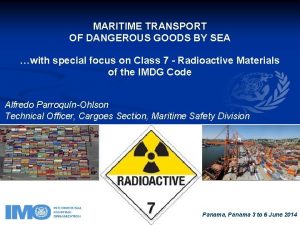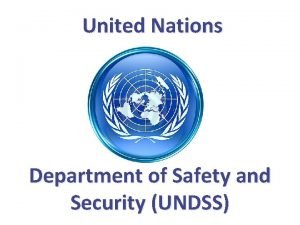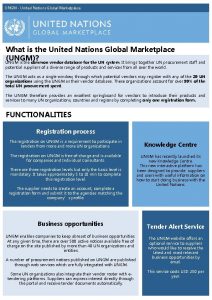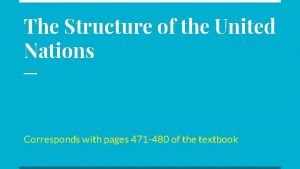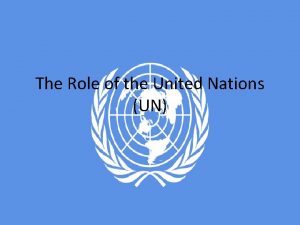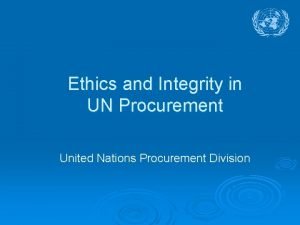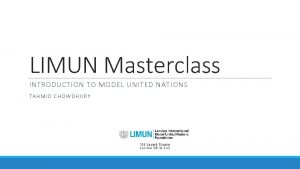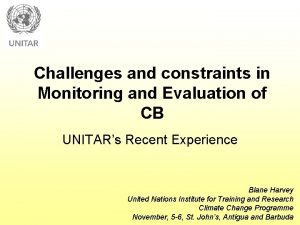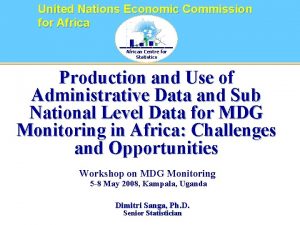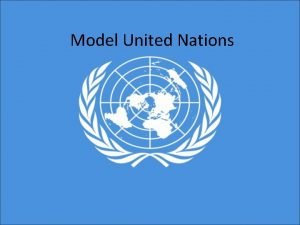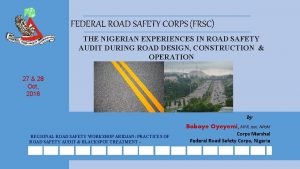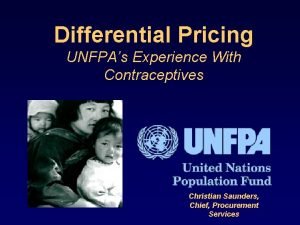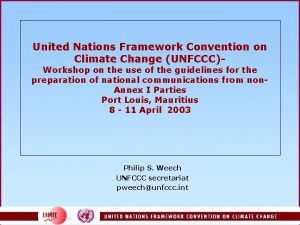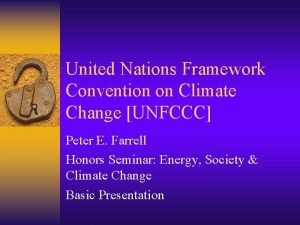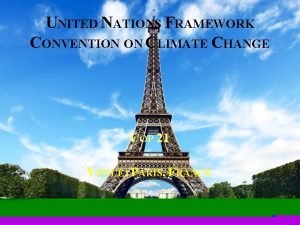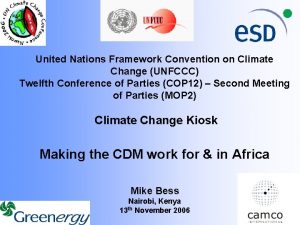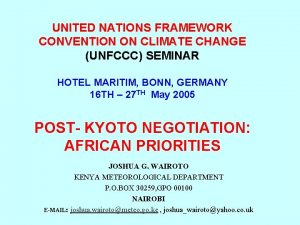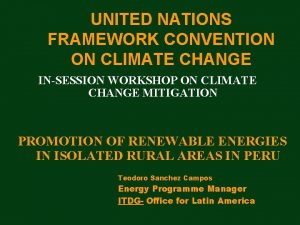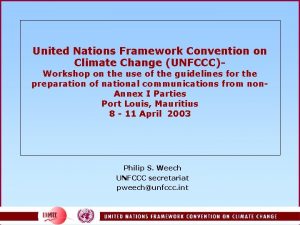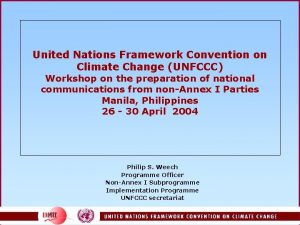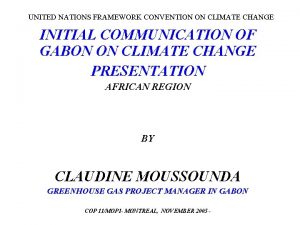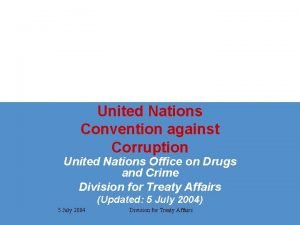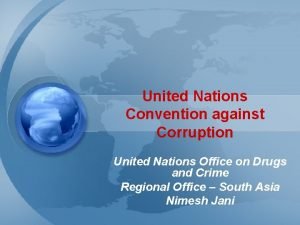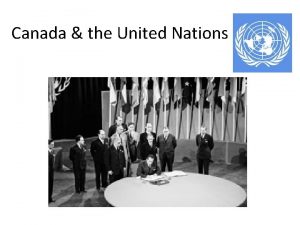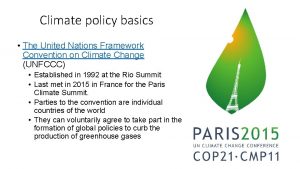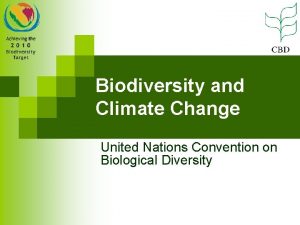United Nations Framework Convention on Climate Change An


















- Slides: 18

United Nations Framework Convention on Climate Change: An Overview Ko Barrett Deputy Director NOAA Climate Program Office 7 February 2013 1

The International Climate Family Tree World Climate Conference WCC 1: WCC 2: WCC 3: World Climate Research Program/Intergovernment al Panel on Climate Change United Nations Framework Convention on Climate Change Global Framework for Climate Services 1979 1991 2009 2

What is the UNFCCC? • An international treaty to cooperatively consider what can be done to limit climate change and cope with climate impacts • Goal is to: Stabilize greenhouse gas concentrations “at a level that would prevent dangerous anthropogenic interference with the climate system…within a time-frame sufficient to allow ecosystems to adapt naturally to climate change, to ensure that food production is not threatened, and to enable economic development to proceed in a sustainable manner. ” 3

2010 2011 2012 2009 2007 2005 1997 1994 1992 1990 UN FC CC UN ne go FC tia CC tio UN ad ns op FC be ted CC gin en ter s in Ky oto to for Pro ce --t o --co Ky ----- l ad op oto --ted --e nte ---Ba li A --r s Co ction into -pe for P n l ce Ca hag an ncu en A Du n Agr ccor rba d ee m Do n Pl en atf ts ha Ga orm tew ay Timeline of the Negotiations

2009: The Copenhagen Accord • High expectations + poor leadership = failure • Set a global goal to hold increase in temperature below 2°C • Provided for mitigation commitments from both developed and developing countries – Specific targets for developed countries – Specific actions for developing countries MRV • Recognized crucial role of reducing deforestation, need for enhanced technology, adaptation and use of markets • Called for scaled up financing – Approaching $30 billion between 2010 and 2012 – Goal of mobilizing $100 billion/year by 2020 Photo Source: ENB

Associations with the Accord • 116 Countries, representing over 80% of global GHG emissions • Includes major countries (e. g. , US, China, India, and Brazil) Source: WRI and UNFCCC

Mitigation Actions Listed • Brazil: 36 -39% below business as usual by 2020 • China: 40 -45% reduction in emissions intensity below 2005 by 2020 • EU: 20 -30% below 1990 levels by 2020 • India: 20 -25% reduction in emissions intensity below 2005 by 2020 • Indonesia: 26 -41% below business as usual by 2020 • Japan: 25% below 1990 by 2020, contingent on others acting • Mexico: up to 30% below business as usual by 2020 • USA: in the range of 17% below 2005 levels by 2020, in conformity with US legislation

2010: The Cancun Agreements • Low expectations + excellent leadership = success • Built upon elements in the Copenhagen Accord to reach agreement on: – Shared Vision – Enhanced Action on Mitigation – Adaptation – Transparency – Finance – Reduced Emissions from Deforestation – Technology Photo Source: ENB

2011: The Durban Platform • The Durban Platform launched “a process to develop a protocol, another legal instrument or an agreed outcome with legal force under the Convention” • The new legal agreement will be “applicable to all Parties” • Negotiations on the future agreement will: • Conclude by 2015 • Enter into effect from 2020 Photo Source: ENB

2012 Negotiations • Transitional year that closed one chapter of negotiations and opened a new one • Made progress on implementing the Copenhagen, Cancun and Durban decisions • Many focused on the Kyoto Protocol Photo Source: ENB

Kyoto Protocol • Second commitment period 2013 -2020 • A subset of countries signed on to the second commitment period (EU, NOR, AUS, CH) 15% • Clean Development Mechanism (CDM) and Emissions Trading to continue • Nitrogen Triflouride (NF 3) added (GWP= 17 k)

Mitigation • Parties agreed to establish a two -year work program to continue the process of clarifying and understanding countries' mitigation pledges • Parallel structure for developed and developing countries IPCC Emissions Scenarios – Both groups communicate targets or actions, and these will be recorded in formal UNFCCC document – Both groups subject to reporting, review and oversight – Parties submit their first biennial reports in 2014 12

Transparency: Monitoring, Reporting and Verification To build confidence that countries are implementing their mitigation efforts. Developed Countries Agreed biennial report guidelines Developing Countries Agreed biennial update report guidelines Agreed international consultation and assessment and review (IAR) analysis (ICA) modalities and guidelines modalities and procedures Agreed a registry will be used as voluntary reporting tool on the web for activities seeking international support or recognition

Markets • Agreed to design a new UNFCCC-administered market mechanism • Established a Framework to link the UNFCCC and market-based mechanisms that Parties develop • Created a work program to elaborate functions of the framework, including: • Procedures to assure environmental integrity • Technical specifications for a tracking and transparency system Source: Scientific American

Reduced Emissions from Deforestation • Guidance for a “REDD+” mechanism – Benchmarks for measuring emissions reductions – Reaffirmed importance of social and environmental safeguards • Finance sources include: – Public and private – Bilateral and multilateral – Market-based measures and offsets

Research and Systematic Observations • Science is integrated throughout the activities of the Convention • There is an agenda item that considers work of specific global observing systems and international and regional research organizations • Research Dialogue provides an opportunity for Parties and these organizations to engage on scientific issues of relevance to the Convention • Will hold a workshop in 2013 on scientific and technical aspects of ecosystems with high-carbon reservoirs not already addressed under the Convention

Agriculture • In 2011, Parties agreed to consider issues related to agriculture • During 2012, Parties exchanged views but were unable to come to agreement on areas of work on this topic under the Convention

Take away messages • The negotiating process plods forward with incremental progress • It will not create a significant policy demand for NACP science in the nearterm • However, advances in understanding of carbon and methane together with policy relevant actions in cities, CAB will matter
 Climate change 2014 mitigation of climate change
Climate change 2014 mitigation of climate change Class 7 dangerous goods
Class 7 dangerous goods Theoretical framework example
Theoretical framework example United nations
United nations United nation department of safety and security
United nation department of safety and security United nation global marketplace
United nation global marketplace Six main organs of the united nations
Six main organs of the united nations Role of united nations
Role of united nations Ethics and integrity at the united nations
Ethics and integrity at the united nations Introduction to model united nations
Introduction to model united nations Unitar united nations
Unitar united nations United nations zambia
United nations zambia United nations
United nations United nations
United nations Model united nations
Model united nations The agency sponsored by the united nations that compiles
The agency sponsored by the united nations that compiles Frsc vision and mission statement
Frsc vision and mission statement Christian saunders united nations
Christian saunders united nations Cold war
Cold war

